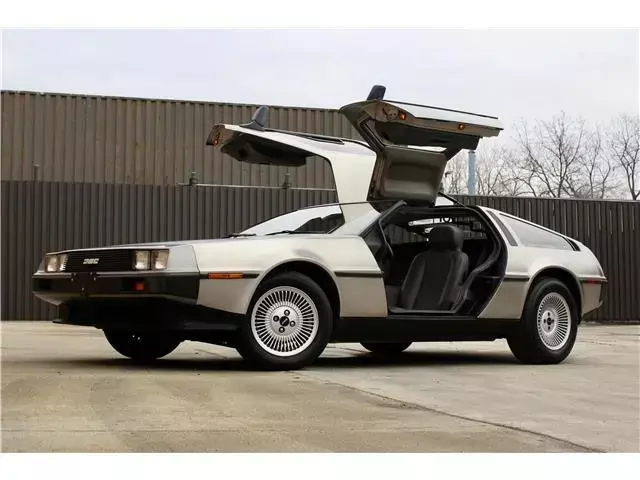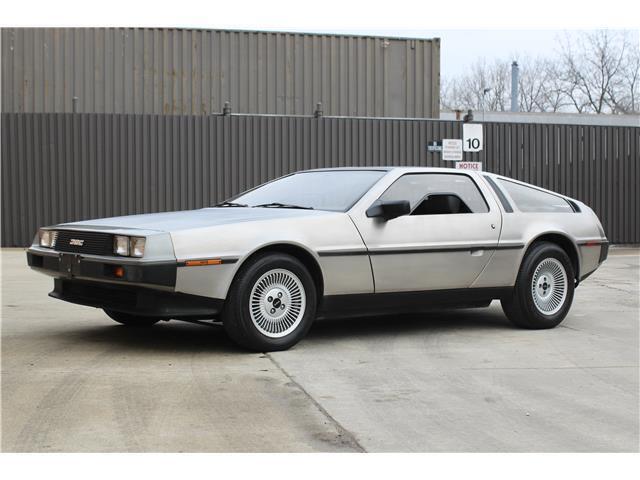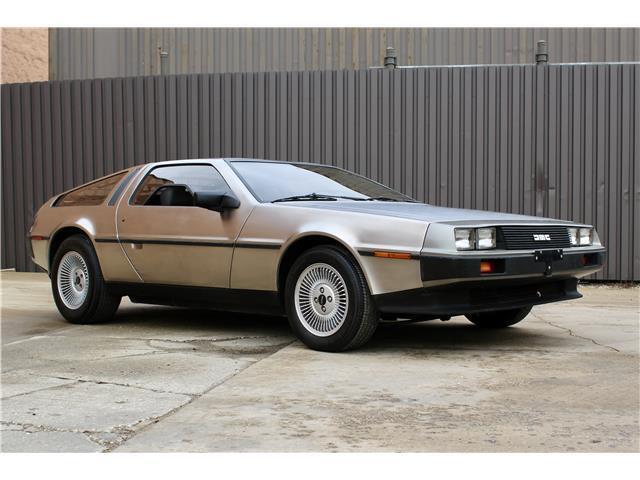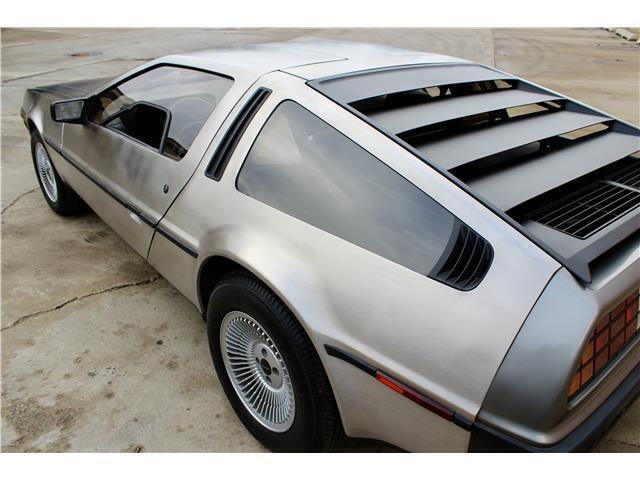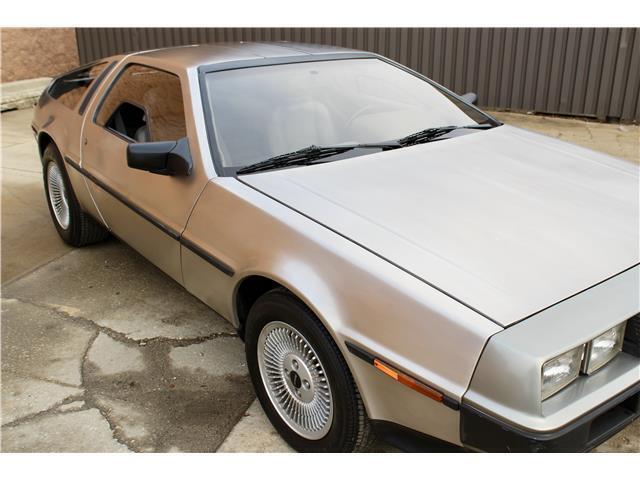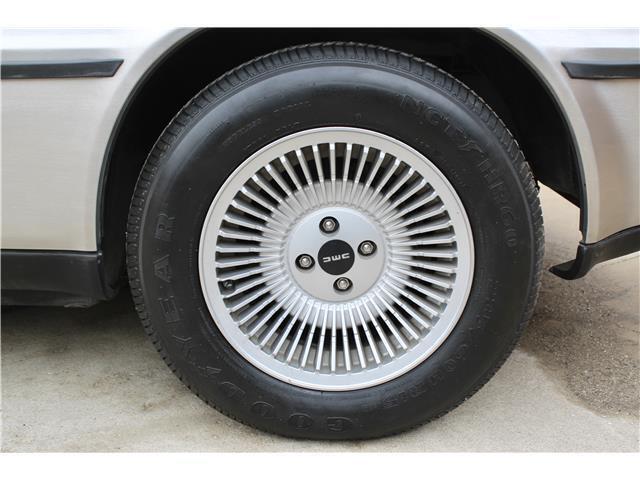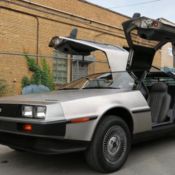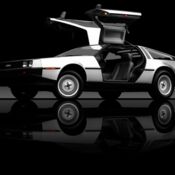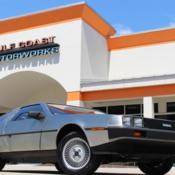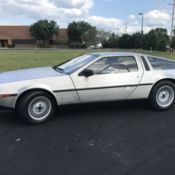1982 DeLorean DMC-12 Incredible 6,887 Original Miles 5 Speed
1982 DeLorean DMC-12
(630) 567-0066(630) 567-0066 Vehicle Original VIN : SCEDT26TXBD005407
| 1982 DeLorean DMC-12 Incredible 6,887 Original Miles 5 Speed
1982 DeLorean DMC-12 6,887 Original Miles Manufactured in October of 1981 Three Owners from New VIN # is SCEDT26TXBD005407
This 1982 DeLorean is an example of the first (and arguably one of the best) years of the all to brief DMC-12 model run and represents an era of automobiles that will never be seen again…
The condition of this car is highly original and very well preserved. The car shows very few signs of age and shows 6,887 original miles on the odometer. It has had three owners from new.
The original owner purchased the car in 1983 from Shepard Chevrolet in Lake Bluff, Illinois, and sold the car in 1986 to a gentleman in Iowa, who kept the car until the current owner purchased the car in 2018.
The documentation includes the DeLorean Motor Company warranty, original owner’s manual, the previous titles and registrations, and various period DeLorean advertisements. Please note this DeLorean is titled as a 1983 model, as it was built in late 1981 as a 1982 model and not sold until 1983.
BODY:
This DeLorean still is completely original and has the original stainless-steel finish applied. All of the body panels are ripple and dent free and have never had any sort of body or accident damage.
The finish is in extremely nice overall condition and retains its original finish, obviously the result of the car being garage kept and well cared for all of its life.
The glass and seals are in very nice condition and there are no leaks evident.
INTERIOR:
The interior is trimmed in the original grey leather. The seating areas are in flawless original condition, as are the door panels, dashboard, and console. The carpet is also in beautiful original condition, and has not been damaged by any effects of sun, spills or rodent damage.
All of the accessories are in working order. The dashboard includes a speedometer and tachometer as well as a radio, fuel gauge, ammeter, and oil pressure and water temperature gauges.
The electric windows are in perfect working condition. The electric window motors have been replaced with updated motors and re-installed. The door locks work as well. The trunk area appears in time capsule preserved condition, the trunk carpet is in perfect condition, and the spare tire, wheel, and trunk accessories are all present and in place.
The gullwing doors are also in perfect working order.
UNDERCARRIAGE:
The underside of the car is in line with a 6,800 mile car and is very well preserved. Every factory mark is still on the car.
ENGINE, TRANSMISSION, and MECHANICALS:
All of the mechanical aspects of the car have been inspected and repaired, if necessary. The motor is original to the car, with all numbers and codes matching, and the transmission is the optional 5-speed manual, which was one of the only options available on the DeLorean.
All of the engine, transmission, and differential fluids have been changed, all belts have been replaced, the cooling system flushed out, and a new battery installed. The fuel system has also been completely cleaned and updated, including the injectors, and there are no issues with starting and running the vehicle.
All of the brakes have also been rebuilt, and the brake hoses replaced.
ENGINE COMPARTMENT:
The engine bay is completely original, with all components in operational condition. Every detail of the engine compartment is well preserved. There is some minor wear to certain painted surfaces that has occurred due to age, but overall, it is very presentable.
TIRES AND WHEELS:
The tires are the original equipment Goodyear NCT tires that were delivered new with the car. There is no wear evident. If the new owner does intend to drive the car, I would recommend removing the tires and preserving them, and purchasing a new set for driving purposes. Michelin and Pirelli make the correct size to fit the front and rear wheels.
The aluminum wheels are in flawless original condition and have with no wear or storage scars evident.
OVERALL DRIVING IMPRESSIONS:
This DeLorean runs as any 6,800 mile car should – it’s nearly brand new! The 2.8-Liter V-6 powerplant runs and accelerates smoothly and very quickly and the 5-speed manual transmission shifts as it should.
The car runs and drives with no issues. Again, the car has had all of the necessary service recently performed including oil change, tune up, installation of new battery and brakes, and gearbox and differential service, and needs absolutely nothing to drive, show, and enjoy. All of the mechanical aspects of the car work as they should.
PLEASE NOTE:
This 1981 DeLorean still retains all of its original components and is the most well-preserved low mileage example I have seen. This means the engine, transmission, rear end, etc. are original to the car. All of the numbers, markings, etc., are correct. Any replacement part used (such as the fuel pump) has been an N.O.S or exact original reproduction part purchased from DMC Motors in Crystal Lake, Illinois. It is an original and very special car that, as evidenced by the low mileage, has been driven very sparingly during the last 43 years…
There is absolutely nothing that needs to be done to this car to drive it occasionally and enjoy it as a showpiece. Again, if the new owner decides to drive it in vintage events or on a regular basis, I would recommend going over the car again for safety and installing new tires, etc. The correct size is still available although Goodyear no longer manufactures them. Either way, the new owner will have a fantastic original DeLorean to drive and show.
Thanks for your interest!
For more on DeLorean and the DMC-12, read on past the photos…
Introduction
The De Lorean DMC-12 is a two-seater sports car that was manufactured by the DeLorean Motor Company (DMC) for the US market from 1981 to 1983. It featured gull-wing doors with a fiberglass underbody to which non-structural brushed stainless steel panels were affixed. Manufactured in Northern Ireland it is most commonly known simply as the DeLorean, as it was the only model ever produced by the company.
The first prototype appeared in March 1976, and production officially began in 1981 (with the first DMC-12 rolling off the production line on January 21) at the DMC factory in Dunmurry, Northern Ireland. Over nine thousand DMC-12s were made before production stopped in December 1982. Today, about 6,500 DeLorean Motor Cars are believed to still exist. It is perhaps best remembered when it shot to worldwide fame in the Back to the Future movie trilogy starring Michael J Fox and Christopher Lloyd. The car was transformed into a time machine by the eccentric scientist Doctor Emmett L. Brown – the company had ceased to exist before the first movie was ever made in 1985.
DeLorean History
In October 1976, the first prototype De Lorean DMC-12 was completed by William T. Collins chief engineer and designer (formerly chief engineer at Pontiac). Originally, the car’s rear-mounted power plant was to be a Citroën Wankel rotary engine, but was replaced with a French-designed and produced PRV (Peugeot-Renault-Volvo) fuel injected V-6 because of the poor fuel economy from the rotary engine, an important issue at a time of world-wide fuel shortages. Collins and De Lorean envisioned a chassis produced from a new and untested manufacturing technology known as Elastic Reservoir Moulding (ERM), which would contribute to the light-weight characteristics of the car while presumably lowering its production costs. This new technology, for which De Lorean had purchased patent rights, would eventually be found to be unsuitable for mass production.
These and other changes to the original concept led to considerable schedule pressures. The entire car was deemed to require almost complete re-engineering, which was turned over to engineer Colin Chapman, founder and owner of Lotus. Chapman replaced most of the unproven material and manufacturing techniques with those currently being employed by Lotus. The Backbone chassis is very similar to the Lotus Esprit. The original Giorgetto Giugiaro body design was left mostly intact, as were the distinctive stainless steel outer skin panels and gull-wing doors.
The DMC-12 would eventually be built in a factory in Dunmurry, Northern Ireland, a neighborhood a few miles from Belfast city centre. Construction on the factory began in October 1978, and although production of the DMC-12 was scheduled to start in 1979, engineering issues and budget overruns delayed production until early 1981. At the time the unemployment rate was high in Northern Ireland and there was no shortage of local residents ready to apply for jobs at the factory. The production personnel were largely inexperienced, but were paid premium wages and supplied with the best equipment available. Most quality issues were solved by 1982 and the cars were sold from dealers with a 12 month, 12,000-mile (19,300 km) warranty and an available five-year, 50,000-mile (80,000 km) service contract.
The Car
Reception by the car buying public and automotive magazines was mixed. Although the early vehicles had impressive waiting lists of anxious consumers, the MSRP sticker price of US $25,000 was cost-prohibitive for the majority of the market – especially for what many considered to be an under-powered and impractical plaything. “It’s not a barn burner..,” observed Road & Track, “..with a 0-60 mph time of 10.5 seconds. Frankly, that’s not quick for a sports/GT car in this price category.”
The stainless steel body panels were an attractive design concept and impervious to corrosion, but in practice the sheen surface tended to show fingerprints. It also meant that the car could not be easily painted; every factory original De Lorean looked virtually identical. Some dealerships painted their cars on delivery to help make theirs more distinctive. DeLorean Motor Company was testing the use of translucent paint to help provide different color options on the cars while also allowing the stainless steel grain to show through, but no cars were sold with factory painted body panels. The only factory option initially available was an automatic transmission. A grey interior was offered later in 1981 as an alternative to the standard black interior. Several accessories including pin-striping and luggage racks helped provide further individuality.
A total of about 9,200 DMC-12s were produced between January 1981 and December 1982 (almost a fifth of these were produced in October 1981), although actual production figures are unclear and estimates differ. About 1,000 models were made between February and May 1982 but not shipped to the US. All of these cars had their Vehicle Identification Numbers (VIN) changed after purchase by ‘Consolidated International’ (now known as Big Lots). Originally 10XXX, 11XXX and 12XXX VINs, these were changed to 15XXX, 16XXX, and 17XXX VINs to make them appear as 1983 models.
During 1981, it was reported there were plans to have made a 4-door version of the car for 1983 – perhaps on a longer wheelbase. Again it was to have been constructed of stainless steel body panels with the familiar gull-wing doors.
The De Lorean Motor Company went bankrupt in late 1982 following John De Lorean’s arrest in October of that year on drug trafficking charges. He was later found not guilty, but it was too late for the DMC-12. Approximately 100 partially assembled DMC’s on the production line were completed by Consolidated International who had a buyback program with DMC and had bought out the remaining unsold cars. The inventory of unused parts left in the factory after the bankruptcy and the parts from the US Warranty Parts Center, as well as parts from the original suppliers that had not yet been delivered to the factory were all shipped to Columbus, Ohio in 1983–1984. A company called KAPAC sold these parts to retail and wholesale customers via mail order. In 1997, De Lorean Motor Company of Texas acquired this inventory.
The Body
The body design of the DMC-12 was a product of Giorgetto Giugiaro of Ital Design and is expressed in brushed SS304 stainless steel. Except for three cars plated in 24-karat gold, all DMC-12s left the factory uncovered by paint or clearcoat. Painted De Loreans do exist, although these were all painted after the cars were purchased from the factory. To train workers, several hundred DMCs were produced without stainless panels, and are referred to as “black cars” or “mules”, in reference to their black fiberglass panels in lieu of stainless, though these were never marketed. Small scratches in the stainless steel body panels can be removed with a non-metallic scouring pad (since metal pads can leave iron particles embedded in the stainless steel which can give the appearance of the stainless “rusting”), or even sandpaper. The stainless steel panels are fixed to a glass-reinforced plastic (GRP, fiberglass) monocoque underbody. The underbody is affixed to a double-Y frame chassis, derived from the Lotus Esprit platform.
The unpainted stainless body creates challenges during restoration of the cars. With an unpainted stainless body, the stainless steel must be reworked to exactly the original shape, contour and grain. De Lorean envisioned that damaged panels would simply be replaced rather than repaired. Even today there are decades worth of new stainless panels still available in most instances.
Another novel feature of the DMC-12 is its gull-wing doors. One interesting fact about these doors is that the workers at the factory used to weld their names, or initials on the inside of the outer door panels on many of the vehicles produced. If you were to remove the outer panel you could actually find out the name of at least one of the individuals who worked on the car. The common problem of supporting the weight of gull-wing doors was solved by other manufacturers with lightweight doors in the Mercedes-Benz 300SL and an air pump in the Bricklin SV-1, although these designs had structural or convenience issues. The DMC-12 features heavy doors supported by cryogenically preset torsion bars and gas-charged struts. These torsion bars were developed by Grumman Aerospace (and built by Unbrako in the UK, a division of SPS Technologies of Jenkintown, PA) to withstand the stresses of supporting the doors. A popular misconception of the DMC-12’s gull-wing doors is that they require far more side clearance to open relative to ordinary side-hinge doors, such as when parked in a parking lot. In fact, the opposite is true: the DMC-12 requires far less clearance than side-hinge doors! These doors, when opening, only require 11 inches (264 mm) clearance outside the line of the car, making opening and closing the doors in crowded parking lots relatively easy. Much like the doors fitted to the Lamborghini Countach, the DMC-12 doors featured small cutout windows, because full-sized windows would not be fully retractable within the short door panels.
Suspension
The underbody and suspension of the DMC-12 were based largely on the Lotus Esprit, with a four-wheel independent suspension, coil springs, and telescopic shock absorbers. The front suspension used double wishbones, while the rear was a multi-link setup. In its original development stages, the car is said to have handled quite well. Considering that Lotus’s reputation was built largely on the handling prowess of the cars the company produced, the DMC-12’s smooth ride wasn’t a surprise. Unfortunately, changing US government bumper height regulations required modifications to the suspension system and an increase in the vehicle’s factory ride height, both of which had adverse effects on the car’s handling capabilities. Many owners have subsequently replaced or modified the front springs to return the front height to the original design specification.
Steering was rack and pinion, with an overall steering ratio of 14.9:1, giving 2.65 turns lock-to-lock and a 35 ft (10.67 m) turning circle. DMC-12s were originally fitted with cast alloy wheels, measuring 14 in (356 mm) in diameter by 6 in (152 mm) wide on the front and 15 in (381 mm) in diameter by 8 in (203 mm) wide on the rear. These were fitted with Goodyear NCT steel-belted radial tires. With the engine being mounted in the very rear of the vehicle, the DMC-12 has a 35 / 65 % weight distribution.
The DMC-12 features power-assisted disc brakes on all wheels, with 10 in (254 mm) rotors front and 10.5 in (267 mm) rear.
Performance
John DeLorean had originally envisioned that the car would produce somewhere around 200 horsepower (150 kW), but eventually settled on a 170 horsepower (130 kW) output for the engine. However, United States emissions regulations required that parts such as catalytic converters should be added to the vehicle before it could be sold there. This caused a 40 horsepower (30 kW) reduction to the vehicle’s power output, a loss which seriously impeded the DMC-12’s performance. When this combined with the suspension system changes, the US version was regarded as disappointing. De Lorean’s comparison literature noted that the DMC-12 could achieve 0–60 mph (0–96 km/h) in 8.8 seconds, respectable for the early 1980s, but when Road & Track magazine tested the car they recorded a time of 10.5 seconds. It is possible that the factory performance numbers were achieved using a European-spec car with the original 170 horsepower (130 kW) engine.
Pricing
The car was named the DMC-12 because of its original price of $12,000. New DMC-12s had a suggested retail price of $25,000 ($650 more when equipped with an automatic transmission). There were extensive waiting lists of people willing to pay up to $10,000 above the list price, however after the collapse of the DeLorean Motor Company, unsold cars were being purchased under the retail price.
The DMC-12 was only available with two factory options including a no-cost manual transmission or automatic transmission ($650) and the choice of a grey or black interior. Several dealer options were available, including a car cover ($117); floor mats ($84); black textured accent stripes ($87); grey scotch-cal accent stripes ($55); a luggage rack ($269) and a ski-rack adapter. The standard feature list included stainless steel body panels; gull-wing doors with cryogenically-treated torsion bars; leather seats/trim; air conditioning; an AM/FM cassette stereo system; power windows, locks and mirrors; a tilt and telescopic steering wheel; tinted glass; body side mouldings; and a rear window defogger.
Right-Hand Drive Models
Despite being produced in Northern Ireland, DMC-12s were primarily intended for the American market. Therefore, all production models were left-hand drive (designed to be driven on the right side of the road). However, evidence survives from as early as April 1981 which indicates that the DeLorean Motor Company was aware of the need to produce a right-hand drive version to supply to world markets such as Ireland, Britain, Australia, New Zealand and Japan, where traffic travels on the left. The first two markets outside of the US were to be the United Kingdom and Germany.
DeLorean knew that to sell DMC-12s in the United Kingdom would mean producing a right-hand drive configuration of the car. The company faced the choice of building right-hand drive models from scratch, or performing a post-production conversion exercise. Given the cost of new body moulds, tooling and a host of specific parts that a factory build right-hand drive configuration would require, the company opted to investigate the idea of a post-production conversion.
Only 16 right-hand drive factory authorized DeLoreans were ever produced. This handful of cars can be divided into two distinct groups:
Recent research has revealed that VINs 752 and 758, once thought to be factory authorized right-hand drive cars, are post-factory conversions carried out by private individuals. Some of the right-hand drive cars have speedometers reading to 140 mph (230 km/h), instead of the US-specification 85 mph (137 km/h).
Changes in Production
Although there were no typical “yearly” updates to the De Lorean, several changes were made to the De Lorean during production. John De Lorean believed that model years were primarily a gimmick used by automobile companies to sell more cars. Instead of making massive changes at the end of the model year, he implemented changes mid-production. This resulted in no clear distinction between the 1981, 1982, and 1983 model years, but with subtle changes taking place almost continuously throughout the life of the DeLorean. The most visible of these changes related to the hood style.
The original hood of the De Lorean had grooves running down both sides which included a gas flap to simplify fuel filling. The gas flap was built so that the trunk could be added to the total cargo area of the De Lorean. These cars typically had a locking gas cap to prevent siphoning. In 1981, the gas flap was removed from the hood of the cars although the hood creases stayed -this style was retained well into 1982. Based on production numbers for all three years, this hood style is probably the most common. After the supply of locking gas caps were exhausted, the company switched to a non-locking version resulting in at least 500 cars with no gas flap but with locking gas caps. The final styling for the hood included the addition of a De Lorean logo and the removal of the grooves, the result was a completely flat hood. All changes to the hood were made not to alter the aesthetics of the car but for a much more practical reason: production of the groove less design was both faster and more reliable – as the stainless steel would often crack in the process of forming the grooves.
Although the styling of the De Lorean’s wheels remained unchanged, the wheels of early-model 1981 vehicles were painted grey. These wheels sported matching grey center caps with an embossed DMC logo. Early into the 1981 production run, these were changed to a polished silver look, with a contrasting black center cap. The embossed logo on the centre caps was painted silver to add contrast.
The original Ducellier alternator supplied with the early production DMC-12s could not provide enough current to supply the car when all lights and electrical options were on – as a result the battery would gradually discharge. Later cars were fitted from the factory with a higher output Motorola alternator which solved the problem. This also is believed to be the reason behind the improvement in the sound quality of the horn – earlier models emitted a weak sound, not loud or strong enough to be effective in normal traffic.
John De Lorean was 6’4? (193 cm) tall, and he designed the car to comfortably fit someone of his stature. For shorter people, the addition of a pull strap made closing the doors much easier from the inside. Pull straps which attached to the existing door handles were manufactured as an add-on for the earlier vehicles. Late-model 1981 cars, and all cars from 1982 and 1983 have doors with the integrated pull straps.
The side bolstering in the De Lorean was originally separate from the main interior pieces. There was a tendency to place pressure on this when entering and exiting the car. This eventually caused the bolstering to become separated from the trim panel. To alleviate this problem cars built in and after late 1981 have one solid trim piece with this bolster permanently attached.
One of the few changes tied directly to a model year is the addition of a foot rest or “dead pedal” – an unusable pedal that was added to the cars to help prevent fatigue whilst driving. These can only be found in cars from 1982 onward.
The first 2,200 cars produced used a windshield-embedded antenna. This type of antenna proved to be inadequate for most motoring needs, so a standard whip antenna was added to the outside of the front right quarter panel. While improving radio reception this resulted in a hole in the stainless steel, and an unsightly antenna. As a result the antenna was again moved, this time to the rear of the car. Automatic antennas were installed under the grills behind the rear driver’s-side window. While giving the reception quality of a whip antenna, these completely disappear from view when not in use.
In 1981 the De Lorean came stocked with a Craig radio; Since the Craig did not have a built-in clock, one was installed in front of the gear shift on the center console. De Lorean switched to an ASI stereo in the middle of the 1982 production which featured an on-board clock – the car’s on-board clock was removed at the same time.
The small sun visors on the De Lorean have vinyl on one side, and headline fabric on the other side. Originally these were installed such that the headliner side would be on the bottom when not in use. Later on in 1981, they were reversed so that the vinyl side would be on the bottom.
Today A very large number of the original cars are still on the road; most estimates put it at 6,500 cars surviving out of just over 9,000 built. There is a very active enthusiast community around the cars, with strong owners’ clubs. There were a number of commercial enterprises set up after the demise of the DeLorean Motor Company to provide parts and service, and most of those are still in existence today with most parts being reasonably priced and still readily available. The DeLorean Motor Company of Texas now owns the large remaining original parts stock from the factory. This is an entirely new ownership which acquired the original company’s name and some of the logos as the trademark registration for these had lapsed. Texas entrepreneur Stephen Wynne is the current owner of DeLorean Motor Company.
Many aftermarket improvements have been offered over time to address some of the flaws in the original production cars, and to improve performance. A common opinion of the car is that in stock form it is somewhat underpowered. A variety of solutions have been implemented to counteract this from complete engine swaps, either to a larger PRV (Peugeot-Renault-Volvo) engine, or to completely different engine such as the Cadillac Northstar.
Return to Production
Due to the continued demand for the DMC-12, the DeLorean Motor Company of Texas has returned the car into a limited production run. The newly produced cars will have a base price of around $60,000 and have new stainless steel frames and lighter fiberglass underbodies, with optional extras such as GPS and an enhanced “Stage 2” 197 bhp engine.
De Lorean, DeLorean, Delorean, deLorean or de Lorean?
DeLorean is more often seen spelled without the space: DeLorean. However, typewritten company documents universally use the space, so this is clearly the company’s chosen (and correct) form. In typeset documents, a half space, not a full space, appears between the two portions, and the same is visible in more stylistic representations, as on the automobiles themselves. This use of a half space probably influenced many people to see no space there.
The company’s founder originally spelled his name as John Delorean. At some point in his life he began using the more Dutch-looking De Lorean instead. During the period the DeLorean Motor Company was operating, he used a space exclusively when spelling his name in the course of business.
The spelling of the name with an intercap L is a form of compromise between the two forms. Some people capitalize the L and leave the D uncapitalized, spelling the name ‘deLorean’ and some even add the space while leaving the D uncapitalized to form the name as ‘de Lorean’, following French usage.
Downturn
The lack of demand, cost overruns, and unfavorable exchange rates began to take their toll on DMC’s cash flow in late 1981. The company had estimated their break-even point to be between 10,000 and 12,000 units, but the limiting demand factors precipitated a falloff in sales to somewhere around 6,000. In response to the income shortfall De Lorean was experiencing, a restructuring plan was devised where a new “DeLorean Motors Holding Company” would be formed. This in turn would have become corporate parent to the DeLorean Motor Company and each of its subsidiaries: DeLorean Motor Cars Limited (manufacturer), DeLorean Motor Cars of America (distributor in the U.S.) and DeLorean Research Partnership (a research and development company). In January 1982, due to SEC questions about the company’s viability, the company was forced to cancel the stock issue for the holding company that DeLorean had hoped would raise about $27 million.
John De Lorean himself then lobbied the British government for aid, but was refused unless he was able to find a matching amount from other investors. What followed is a matter of debate between the British government, the FBI, the DEA, De Lorean, his investors, and the US court system. At some point in 1982, John De Lorean became the target of an FBI sting operation designed to arrest drug trafficking criminals. He was arrested in October 1982 and charged with conspiring to smuggle $24 million worth of cocaine into the US. The key element of evidence for the prosecution was a videotape showing DeLorean discussing the drugs deal with undercover FBI agents Benedict (Ben) Tisa and West. However De Lorean’s attorney Howard Weitzman successfully demonstrated to the court that he was coerced into participation in the deal by the agents who initially approached him as legitimate investors. He was acquitted of all charges, but his reputation was forever tarnished. After his trial and subsequent acquittal, De Lorean quipped, “Would you buy a used car from me?”
In the end, sufficient funds could not be raised to keep the company alive. The De Lorean Motor Company went bust in 1982, taking with it 2,500 jobs and over US $100 million in investments. The British government attempted to revive some usable remnants of the manufacturing facility without success, and the Dunmurry factory was closed. De Lorean himself retired in New Jersey, and the dream with which he had mesmerized Britain’s Labour government, of industry rising out of the ashes of Northern Ireland’s sectarian conflict, was shattered. He claimed that the DMCL was deliberately closed for political reasons, and at the time of closing was a solidly viable company with millions of dollars in the bank and two years of dealer orders on the books.
Despite being cleared of all drug trafficking charges, DeLorean still had to battle many legal cases (stemming from the company’s bankruptcy) well into the 1990s. He personally declared bankruptcy in September 1999 and was evicted from his 434-acre estate in New Jersey in March of 2000. He passed away on March 19th, 2005, of stroke complications at age 80.
**Article courtesy of Classic Cars Global
Specifications
Engine:
Type: Light-alloy 90deg V6, with overhead camshafts. Displacement: 2.85 liters (174 cubic inches) Bore & stroke: 91x73mm Compression: 8.8:1 Block type: Light-alloy with cast iron cyl. liners. Cyl. heads: Light-alloy, cross-flow, hemi-chambers. Cooling system: Water/Ethylene Glycol, radiator forward with twin thermostatically controlled fans Fuel system: C.I.S. Fuel-injection, Bosch K-Jetronic Ignition system, Breakerless, electronic/Bosch. Emission control: Lambda Sond/catalytic, unleaded fuel.
Drivetrain:
Engine location: Rear-mounted. Transmission: 5 speed, fully synchronized or 3 speed automatic Final drive Trans-axle/dbl. universal. half-shafts, ratio: 3.44:1.
Body:
Construction: Structural-composite single piece underbody with corrosion free outer body panels; 304 stainless steel.
Chassis:
Construction Corrosion protected steel backbone frame with fore and aft wishbones, supporting cross members and 4-wheel independent suspension; Controlled impact crush areas.
Suspension:
Front Compliant, unequal length wishbones and coil boxed spring, telescopic shock absorbers and anti-roll bar. Rear Compliant, diagonal trailing radius arms with upper and lower links, coil spring with telescopic shock absorbers.
Steering:
Type: Rack and pinion Min. Turn: 5.334 meters (17.5 feet) Turning circle: 10.67 meters, curb to curb (35 feet) Wheel turns: 2.65 (lock to lock)
Brakes:
Type: Power assisted discs, front and rear Disc diameter: 254mm (10 inches) front, 267mm (10.5 inches) rear Parking brake: Mechanical, self adjusting, acting on rear discs
Wheels/Tires:
Wheels: Cast light alloy, 357mm x 152mm (14 inches x 6 inches) front; 381mm x 203mm (15 inches x 8 inches) rear Tires: Goodyear NCT steel belted radial
Dimensions and Capacities:
Length overall: 4267mm (168.0 inches) Wheelbase: 2408mm (94.8 inches) Height (Door Open) Height: 1140mm (44.88 inches) Width overall: 1988mm (78.3 inches) Front track 1590mm (62.6 inches) Rear track 1588mm (62.5 inches) Ground Clearance – Front 142mm (5.6 inches) Ground Clearance – Rear 155mm (6.10 inches) Weight: 1233kg (2712 pounds) with full tank Fuel Capacity: 51.6 liters (13.2 gallons) Luggage space: 396 liters (14 cubic feet)
Standard Features:
Stainless steel body panels Counter-balanced gull-wing doors Leather seats and trim Air conditioning Multi-speaker, high output stereo system with cassette Power windows Tilt and telescopic steering wheel Dual electric remote side mirrors Full instrumentation Central door locking system Tinted glass Body side moldings Intermittent windshield wipers Sylvania halogen headlamps Engine/luggage compartment lights Interior hood and engine compartment release Electric rear window defogger
…The following is an excerpt of an Article courtesy of Dan Jedlicka, author of “Road Tests and Classic Cars”
DeLorean DMC-12
The 1981-83 DeLorean DMC-12 sports car is best remembered for its flip-up doors and prominent role as the car modified for time travel in the popular “Back to the Future” movies.
Few Americans knew much about the car, which was built in Northern Ireland by a company headed by flashy former General Motors top executive John Z. DeLorean. Only 8,583 DeLoreans were built before the company went out of business,, including several gold-plated ones for an American Express Christmas catalog.
The DeLorean DMC-12’s history is almost as much about John DeLorean as it is about his car. He was a brilliant auto engineer and the youngest vice president in GM history. He successfully headed General Motors’ Chevrolet and Pontiac divisions, where he was behind the iconic Pontiac GTO muscle car.
Tall, handsome DeLorean was a favorite of the media and got lots of publicity while at GM because he was flamboyant, outspoken and successful. Other GM top executives were bland cookie-cutter “company men.”.
DeLorean wore his hair long, married several beautiful young women and often drove exotic foreign sports cars instead of Chevy Corvettes, when GM’s top executives were supposed to be seen in only GM cars. Hard-working and seemingly tireless, DeLorean may have become GM’s president if he had toned down his lifestyle.
Finally, in the early 1970s, DeLorean left GM to build a “safety minded” sports car. After numerous talks with various countries, DeLorean persuaded the British government to back his car venture in severely depressed, strife-torn Northern Ireland, which had few decent jobs. It also was where England was desperate to end violence between Catholics and Protestants.
The DeLorean Motor Co. was built a shiny new factory near Belfast, which opened in December, 1980, with some 600 workers. The first car came off the line on December 3 that year. Ultimately, several thousand people reportedly held jobs in the facility, which brought relative peace to the area.
DeLorean was happy not only to get England’s financial support but his automaking operation made it virtually impossible for the British government to close down the factory if things didn’t go severely wrong (which they eventually did), without inciting violence in the area.
Things went wrong, partly because the DeLorean car operation began swallowing vast sums of money. They came not only from the British government, but also from Wall Street’s largest brokerage and banking houses–and affluent individuals. DeLorean remained “golden” in the media, long after he left GM.
The DeLorean DMC-12 was at the center of the problems. Initially designed by DeLorean’s hand-picked Americans, it soon was also given to engineers from England’s Lotus racing and production car facility in that country. Lotus personnel mainly knew how to build specialized, world-class, hand-built race cars, not mass-produced passenger cars. The small number of road cars that Lotus did build were generally unreliable and had sloppy quality.
Constant battles erupted between American and Lotus personnel, and top DeLorean executives also were baffled by John DeLorean’s seeming lack of interest in his car after the factory operation got underway.
By most accounts, DeLorean rarely visited the plant and didn’t get involved with many of the car’s design features. Rather, he reportedly spent most of his time in his New York penthouse office and traveling about, dreaming up other projects and constantly raising more money for the car operation. He’d wasted years nailing down a government that would give him maximum financial assistance to build his car.
All this led to major delays. The car should have come out years earlier for a much lower price. When new, the unproven DeLorean DMC-12 cost a stiff $25,000, when you could buy an established Chevy Corvette for about $16,000. And there weren’t many buyers for the DeLorean when it debuted, partly because of its price, unproven nature and the fact that the U.S. economy was in poor shape.
Making matters worse was the fact that far too many DeLoreans DMC-12s were built for the slim U.S. market and consequently just sat in storage areas. Even established sports car producers such as Jaguar and Porsche had taken years to develop a solid market for their cars.
The most noteworthy features of the DeLorean DMC-12 were its flip-up doors and unpainted stainless steel body. The car wore no paint partly because panted cars would have raised the cost of the already overpriced auto.
Many DeLoreans, especially the first ones, had poor quality and sloppily produced interiors because there hadn’t been time to train the plant’s workers how to build cars. Doors leaked, and the car had electrical gremlins, among other problems.
This forced the DeLorean operation to set up several U.S. “Quality Assurance Centers.” They did major reworking of the autos before delivery to dealers and ate heavily into company profits. At one point, it took 140 hours to make the DeLorean suitable for sale–at a cost of up to $2,000 per auto.
One investor in the DeLorean auto operation was national television personality Johnny Carson. After taking delivery of his new DeLorean, the car broke down after he drove it just a few miles. A new engine part was rushed to the scene, but that part also soon broke. One can only imagine how unhappy that made Carson, who had put a good chunk of money into the operation.
There seemed to be no end to glitches. The DeLorean DMC-12 had stainless-steel body panels that soon were covered in hard-to-remove fingerprints when parked in public areas. And the doors, which were difficult to close from the inside, opened upward almost purely for dramatic effect to attract buyers. In contrast, the 1950s Mercedes-Benz 300SL sports car had flip-up doors because its race-car-frame design left no room for conventional ones.
A car collector friend of mine who bought two DeLoreans DMC-12s for relatively low prices keeps a hammer on the passenger-side floor when he drives one. That’s because one day the doors made it impossible to get out of the car and he had to drive to an auto service facility, which helped him escape. “If I get trapped again, and the car catches on fire, I’ll use the hammer to break a window,” he said.
After testing one of the first DeLoreans DMC-12s in America, I wrote for a Chicago newspaper that the car was professionally designed, but criticized its overly stiff ride and average acceleration. I said it was “for jet-setters, high rollers and those with plenty of money who want to be the first in the country club parking lot with it.” It clearly needed further development.
To save money, the rear-engine DeLorean had a small, 130-horsepower V-6 used in Volvo, Peugeot and Renault family cars. The 0-60 mph time was a leisurely 9.5-10 seconds, compared with 7.2 for a Corvette and 6.3 for a Porsche. It didn’t help that the DeLorean DMC-12 was overweight–it had too much luxury equipment for a zoomy sports car at that time.
Still, the DeLorean DMC-12 looked racy, and its steering, braking and handling were good. After all, world-championship Lotus knew a thing or two about such things. The body was styled by Giorgetto Giugiaro, who reportedly based its styling on a 1970 design exercise he’d done for Porsche.
Success mainly depended on strong U.S. sales. But sales were only moderately decent here during early 1981. DeLorean nevertheless kept trying to sell too many cars in a limited sports car market with a marginal car during a bad economic period.
Then things fell apart financially and the operation collapsed in 1982, with a few 1982 models sold as 1983 cars. Hundreds of millions of dollars had been squandered on the project on both sides of the Atlantic.
DeLorean, himself, was arrested in late 1982 on charges of drug trafficking–allegedly to make money to keep his auto operation alive. He was cleared of the drug charges, claiming entrapment, but then kept a fairly low profile until his death after a stroke in March, 2005 at the age of 80.
I last talked face-to-face with DeLorean in 1973, when he had just left General Motors, but spoke via phone with him around 2000, when he was on the East Coast.
“Why, I haven’t talked to you in about 1,000 years,” DeLorean said, sounding as confident and optimistic as when I first interviewed him in his office when he was Pontiac’s boss in the 1960s. He then began describing the 200-plus mph sports car he said he was designing with the help of ultra-light aircraft producers on the West Coast.
“It can be done,” he said. “I can do it.”
The car was never built.
And more on the DeLorean…
The DeLorean Motor Company, founded in 1975, was the most famous automotive experiment since Tucker. Embroiled in scandal and allegations of fraud, the company came crashing down after its founder, John Z. DeLorean, was arrested in 1982, the target of a drug-trafficking sting operation. When the car factory shut down, angry workers chucked tooling into the ocean. The DeLorean-built vehicle was a rolling punchline when Hollywood chose one as Doc Brown’s 88-mph time machine in Back to the Future, which hit theaters in 1985. But the 38 years since the movie’s debut have been kind to DeLorean’s only model, the DMC-12. Very kind, all things considered. A starring role as the most famous movie-car ever (other than, maybe, James Bond’s Aston Martin) certainly helps. The cultural relevance of the Back to the Future DeLorean is so massive that, in 2021, it was added to the National Historic Vehicle Register. The market for the cars is healthy, the community around them is vibrant and multigenerational, the aftermarket support for them is vast, and “new” DeLoreans are in the works thanks to the founder’s daughter. Can you say that about any other low-volume carmaker that went bust 40 years ago? The DeLorean story is a good one, with lots of layers and many different perspectives. It has also been told many times, but here’s a short version… John Zachary DeLorean was the son of a Romanian-born Ford worker, but it was at General Motors that he became a golden boy. The youngest man to head a division at GM (Pontiac), he presided over the development and production of the GTO, which ignited the muscle-car explosion of the ’60s. He then headed up Chevrolet starting in 1969. Then, instead of climbing further up the GM ladder, he resigned in 1973 to start his own car company. DeLorean met with Giorgetto Giugiaro in 1974 to pursue one of the Italian designer’s signature wedge shapes, his main wishes being for a car with an engine in back, gullwing doors, and stainless steel body. A prototype DeLorean called the DSV-1 (DeLorean Safety Vehicle) was ready in 1976. Under the skin, though, significant revisions to the structure were needed, and for this DeLorean turned to Colin Chapman and the chassis masters at Lotus. The team used a backbone very similar to the one on the Esprit, onto which a fiberglass body was mounted, and then stainless steel panels on top of that. A planned Citroën/NSU rotary engine was also abandoned due to lack of availability, and instead DeLorean chose the 2849-cc Peugeot-Renault-Volvo (PRV) V-6, mounted in the rear and mated to either a five-speed manual or a three-speed automatic. U.S.-spec cars made 130 hp, Euro cars 155. Double wishbones with coil springs and telescopic shocks make up the suspension at the front, while the rear is a multi-link system, also with coil springs and telescopic shocks. Nearly two-thirds of the weight is at the back. In 1978, DeLorean got $12.5M in investment capital from high-profile folks like Sammy Davis Jr. and Pan Am boss Juan Trippe. He had also talked the British government into backing the construction of his factory in Troubles-era Northern Ireland, and the facility opened in 1980 in Dunmurry, near Belfast, providing desperately needed jobs for 1000 workers. In April 1981, the first batch of U.S.-market cars arrived in Long Beach. The car’s official name, DMC-12, referred to the target price of 12 grand, but base price had ballooned to around $25K—about $81K in today’s money. MSRP eventually grew to $29,825 in 1983 and again to $34K in 1983. No domestic-based upstart had successfully gone up against the Big Three in decades, and despite the price increase, it was easy for people to root against the old guard and cheer on the new kid on the block. That included the fine folks in the automotive media. “Our first impressions are overwhelmingly positive,” said Car and Driver. “The handling is safe and satisfying, the V-6 engine surprisingly mellow in its newest assignment. The interior is roomy, comfortable, and reasonably well thought out. Most important, the DeLorean passes the critical enthusiast’s test: it’s fun to drive.” Road & Track lamented the lack of straight-line oomph, concluding it was more GT than sports car, but added “the engine’s flexibility makes up for its lack of brute horsepower.” R&T was also surprised to find it “has none of the kit-car feel that many critics expected,” and with more than a bit of prescience surmised that “it may well be that the DeLorean will become a cult car, purchased for status reasons by persons wishing to be seen as individualists.” Despite the reviews, however, the cars weren’t selling well. Funding dwindled, and a plan to restructure the company and take it public didn’t pan out. The DeLorean Motor Cars went into receivership, just in time for the launch of a new line of DeLorean-branded men’s toiletries. In December 1982, Colin Chapman—not long after answering tough questions about missing money from his deal with DeLorean, but before he could get into serious trouble—suddenly died of a heart attack at age 54. Group Lotus’s finance director Fred Bushell was very much alive, however, and he was sentenced to three years in jail. John DeLorean, meanwhile, had been arrested in 1982 while trying to raise capital in the infamous FBI cocaine-trafficking sting operation, “Operation Full Circle.” After a five-month trial, the jury concluded DeLorean was a victim of entrapment and found him not guilty. A grand jury in Detroit also found him not guilty on multiple counts of fraud, racketeering, and tax evasion. The ruling in the court of public opinion was another story. Despite a brilliant career, DeLorean became the eternal butt of cocaine jokes, and the former industry superstar never had another successful car venture, despite trying. He spent much of the rest of his life in and out of court and eventually sold his massive estate in Bedminster, New Jersey to a golf-course developer. In time, it wound up in the hands of Donald Trump. The car of course was a big screen star, and DeLoreans became easily as much movie props and symbols of ’80s excess as they were cars. Only about 9000 were built, and yet everybody knows what a DeLorean is when they see one. Does everybody want to own it? Of course not, but plenty of people do, and owning one can be surprisingly easy for an orphan performance car like this. Since parts, service, restoration and entire cars are available from the modern DeLorean Motor Company. Otherwise known as Classic DMC, it is a firm north of Houston and Crystal Lake, Illinois that acquired the original company’s parts inventory, factory drawings, and logo. It also manufactures new and improved DeLorean parts. The community of DeLorean lovers is also vast, passionate and knowledgeable, and doesn’t take itself too seriously. Always culturally relevant but not always for the right reasons, DeLoreans haven’t really been cheap for a long time, just inexpensive relative to their rarity, fame, and the segment of the market they occupied when new. Like so many cars in the 2010s and especially during the 2020s, though, DeLoreans have ridden the ’80s nostalgia synthwave. As Gen Xers who want to unleash their inner Marty McFly approach their peak earning years, the cars have gotten more expensive. Most DeLoreans were sold in America, but the cars are world famous and a few have been exported. Despite their factory home in the UK, only somewhere around 15 DeLoreans were sold in right-hand drive, converted in period by a third party. There’s also something of a separate market for well-done clones of the Back to the Future time machine, and they can sell for prices as big as the car show crowds they’ll inevitably draw. Two have sold on Bring a Trailer for over $150K.
As for the regular old DMC-12s that don’t have a flux capacitor, though, they’re still popular with a wide set of enthusiasts. Unsurprisingly, a lot of buyer interest comes from Gen Xers, with 41 percent of DeLorean insurance quotes coming from that generation. But they’re also popular with millennials, the older members of which had a taste of the ’80s and the Back to the Future sequels. The DeLorean had plenty of ingredients to be a footnote of automotive history. It was short-lived. It wasn’t a groundbreaking performer. But those movies and the salacious story behind the cars are the double stack of cultural relevance that keeps these cars desirable. Unlike many collector cars, people don’t buy a DeLorean because it’s a revelation to drive, because it won some famous race, or because their dad had one. They buy it for the image, the history, and the doors.
From Car and Driver, July 1, 1981… 1981 De Lorean First Drive To build good silver bullets or bad silver bullets, that is the question. We’re slicing through the heavens at Mach 2, steeped to the gills in Dom Perignon and beluga caviar, when the irony of it all slaps me sober. We survived the week of overindulgence, but all sight of our mission—tracking jet-setter John Z. DeLorean as he launches his dream in Northern Ireland—was lost somewhere between the London Ritz and Annabel’s Discotheque. A cortege of distinguished American motorjournalists has been diddled again; every one of us is rushing back to the typewriter with more questions than answers.
Will the DeLorean ever make the trip to America? Will the car nuts, depositors, dealers, and investors appreciate it when it gets here? Will the firm even exist a year from now? And most important of all, will John Z., or any mere mortal for that matter, be able to overcome the manufacturing problems inevitable when sixteen-odd snips of stainless steel are spot-welded together to make two gull wings, which in turn must be grafted to a complex, steel-back-boned, plastic-bodied. stainless-skinned silver bullet of a sports car? The world’s hands-on debut of the DeLorean after years of anticipation did resolve a couple of longstanding concerns. First of all, this is unquestionably the most ambitious attempt at running-before-walking ever seen in the variegated history of the auto industry. The backbone frame is easy but expensive, the molded-plastic body complicated and expensive. The gull-wing doors are currently smack-dab in the middle of a no-man’s land in terms of manufacturing experience: Mercedes-Benz broke the molds after 1400 300SLs, and Malcolm Bricklin went bust squeezing the next couple thousand winged cars out of his Canadian plant. What’s more, the DeLorean is first packed with the power accessories and miles of wiring that go with a luxury ride these days, and only then sealed up in its silver wrapper. To find a more-complex-to-build car, you might try Rolls-Royce, but it crafts only a few thousand units a year and their prices run into six figures. It’s a pity the DeLorean is so tough to build at the moment, because our first impressions are overwhelmingly positive. Giugiaro’s rounded-doorstop sculpture looks magnificent in the flesh, and the machinery is good enough to spark a fiery love affair after one quick drive around the block. The DeLorean is not a hard-edged answer to the 911 Porsche, nor is it another fatuous Corvette-clone. And while it stretches the established sports-car performance envelope not an iota, this car is at least happy with itself. The handling is safe and satisfying, the V-6 engine surprisingly mellow in its newest assignment. The interior is roomy, comfortable, and reasonably well thought out. Most important, the DeLorean passes the critical enthusiast’s test: it’s fun to drive. You start a trip by yanking smartly at the plastic exterior door handle and avoiding the sharp, eye-poker edges of the gull wing as you fall into the wrinkled-leather seat. The wing retracts easily with a tug on a subway strap that dangles from the inside handle, but it takes a brisk swing to slam home the 90-pound portal with sufficient force to secure both the front and the rear latch. Your next impression is that you’re entombed. There’s a fat A-pillar uncomfortably close to the center of your forward vision and absolutely no hint of the DeLorean’s hood or forward exshield. The windowsill to the left is at neck level, there’s an awkward molding running horizontally through the side glass at eye level, the rear window is full of black, half-closed Venetian blinds, and the bulky backbone runs a few inches inboard of your right armpit. Furthermore, the DeLorean is darker than a snake pit inside, thanks to the modest glass area, tinted wi
|
